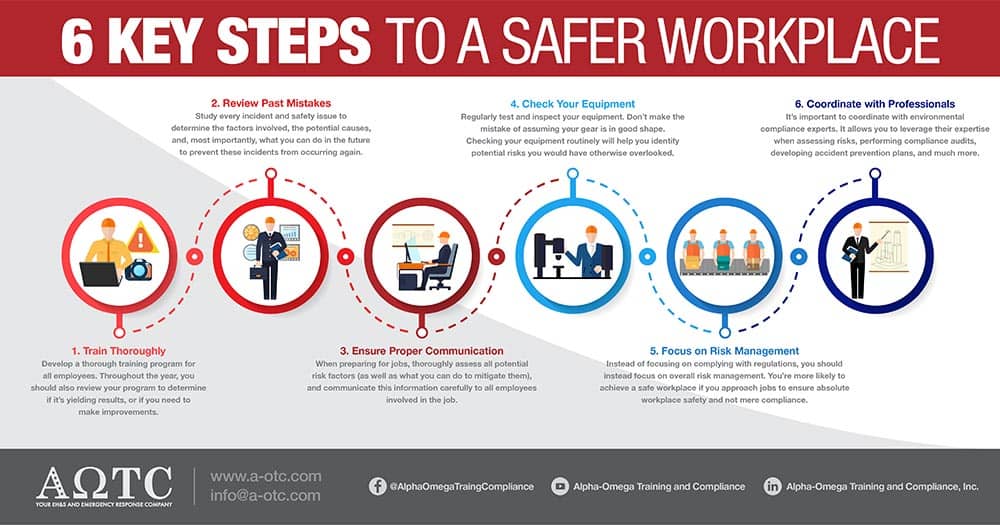Environmental compliance and workplace safety are essential in numerous industries. If you run a business or supervise a team, there’s a good chance you’re responsible for making sure you comply with all regulations and achieve a safe working environment for every project. The following tips will help you do just that. Just remember, while these safety and compliance examples are helpful, they’re also general. The specific nature of your work may require taking additional steps to optimize environmental compliance and overall safety.
Table of Contents
6 Best Ways to Ensure Environmental Compliance and Workplace Safety
We will now discuss the best ways to ensure environmental compliance and workplace safety.
1. Train Thoroughly
You may be a member of your company most responsible for ensuring environmental compliance and a safe working environment for everyone. However, it’s important to remember that every member of a team can potentially create an unsafe situation or fail to avoid potential hazards if they don’t have the proper knowledge. That’s why it’s essential to develop a thorough training program for all employees.
Key aspects of an effective training program should include:
- Regular training: Conduct environmental compliance and workplace safety training on an annual basis.
- Continuous Improvement: Review your program throughout the year to determine its effectiveness and make improvements as needed.
- Adaptive training: Update your safety training program to address new hazards or situations as your company takes on different projects.
- Inclusion: All employees should be part of the training program to maintain a comprehensive knowledge of safety procedures.
Throughout the year, you should also review your program to determine if it’s yielding results or if you need to make improvements. Keep in mind that your employees shouldn’t undergo environmental compliance and workplace safety training once. All workers must remember everything they need to know about keeping one another safe on the job. Therefore, you should require employees to undergo training on an annual basis. Additionally, if your company begins working on projects that potentially involve hazards and situations that past projects did not involve, you might also need to update your safety training program accordingly. For example, maybe your company is starting to work on job sites that could potentially expose workers to hazardous chemicals. You need to update your training to account for this.
2. Review Past Mistakes
Your goal should be to ensure workplace safety and environmental compliance. Unfortunately, accidents can occur. Even if you manage to avoid them in the future, there’s a good chance your company has had incidents in the past.
Consider these steps when reviewing past incidents:
- Incident analysis: Study every incident and safety issue to understand the factors involved.
- Root cause identification: Determine the potential causes of each incident.
- Prevention strategies: Identify ways to prevent these incidents from occurring again in the future.
- Training program updates: Use your findings to update your training program and safety plans.
Make sure you learn from them. Study every incident and safety issue to determine the factors involved, the potential causes, and, most importantly, what you can do in the future to prevent these incidents from occurring again. This will help you effectively update your training program and all related workplace safety plans.
3. Ensure Proper Communication
Regardless of your specific industry, you probably understand the importance of communicating your goals to all participating team members when preparing to work at a job site. You don’t want to waste time and money because your employees don’t know what they’re specifically supposed to achieve. This same principle should apply to workplace safety and environmental compliance.
When preparing for jobs, thoroughly assess all potential risk factors (as well as what you can do to mitigate them), and communicate this information carefully to all employees involved in the job. You might even want to create documents explaining potential risk factors before each project. If, for instance, a team member that was going to work on a particular job had to back out at the last minute because they were ill, someone would naturally replace them. It’s crucial that their replacement also be familiar with the hazards that may be present at the job site.
To enhance communication effectiveness, consider implementing the following strategies:
- Interactive Communication: Encourage a two-way dialogue about safety, and listen to employees’ concerns and suggestions.
- Informative & Positive Communication: Provide employees with necessary safety information under all conditions and foster a positive exchange of ideas and information to improve workplace safety.
- Avoid Communication Barriers: Try to eliminate obstacles that can disrupt the communication process. For instance, ensure your safety message is clear, concise, and not overwhelming and that expectations are well defined. Also, remember to listen to employees’ feedback as part of the communication process.
- Plan Your Message: Be clear about the points you want to make, organize your thoughts logically, and keep your communications simple and precise. This will help prevent any misinterpretation.
- Repetition and Demonstration: Repeat your safety message as needed and use demonstrations when appropriate for better understanding and retention of safety information.
- Remember, failure to communicate safety information effectively can lead to accidents, inability to comply with regulations, and even risks to the community and environment. With a thorough document, you can share this information with employees at the last minute when situations like this one arise, thus ensuring effective communication in your workplace.
4. Check Your Equipment
You probably don’t need to be told that using the proper equipment is key to workplace safety and environmental compliance. This includes both the tools your employees may use on a given job, as well as any safety gear or equipment they may bring with them to job sites. However, it’s also essential that you regularly test and inspect your equipment. Don’t make the mistake of assuming your gear is in good shape. Checking your equipment routinely will help you identify potential risks you would have otherwise overlooked. Depending on the nature of your work, you might even want to check all equipment before each and every job.
5. Focus on Risk Management
Environmental compliance for workplace safety shouldn’t simply involve striving to comply with all applicable regulations. After all, you might know that regulations are frequently changed and updated. In fact, one of your top responsibilities may involve regularly reviewing regulations to stay abreast of these changes.
At this point, it’s important to remember a few key points in risk management:
- Develop a transparent company culture where potential hazards and mitigations are clearly communicated to all employees.
- Identify, assess, manage, and monitor risks regularly to be prepared for them.
- Get the necessary help in terms of policy/compliance infrastructure to ensure worker protection and minimize risk. This might involve hiring the right people for the team or seeking advice from external advisors.
- Conduct a risk and SWOT analysis to proactively identify exposure and address potential concerns around employee physical and mental health.
- Create contingency plans and get the right types of insurance. Communicate these plans to your workers for shared responsibility and protection.
- Strive for a balance between managing workplace complexities and protecting the company from fines, penalties, and lawsuits.
That means you can’t necessarily be certain that complying with the applicable regulations will ensure complete workplace safety. The fact that regulations get updated means they sometimes fail to address all necessary hazards and issues. If they were always perfect, no one would ever have to change them. Remember this when developing environmental compliance plans for workplace safety. Instead of focusing on complying with regulations, you should instead focus on overall risk management. That’s (of course) not to say that you should disregard environmental compliance. It will always be important to understand and comply with regulations and laws. However, you’re even more likely to achieve a safe workplace if you approach jobs to ensure absolute workplace safety and not mere compliance.
6. Coordinate with Professionals
Environmental compliance can be a complicated subject. Without the proper training and education, there’s a good chance you don’t understand it as thoroughly as you need to if workplace safety is your goal. That’s a key reason it’s important to coordinate with environmental compliance experts. It allows you to leverage their expertise when assessing risks, performing compliance audits, developing accident prevention plans, and much more. It also gives your workers the peace of mind that comes from knowing their employer is working with professionals to ensure complete safety. This has actually been shown to improve employee engagement. Workers have more respect for their employers (and find it easier to focus on their tasks) when they believe safety is a top priority.
The Importance of Environmental Compliance and Workplace Safety
Keep in mind that these are a few important safety and compliance examples to remember when developing workplace safety plans. You need to be vigilant when preparing for jobs. If you are, you’ll be far less likely to face the consequences of non-compliance or workplace accidents.
If you need assistance in making your workplace safer and more compliant, don’t hesitate to reach out to Alpha-Omega Training & Compliance. We offer environmental compliance services that will help you minimize risks, save money, and avoid regulatory penalties.

